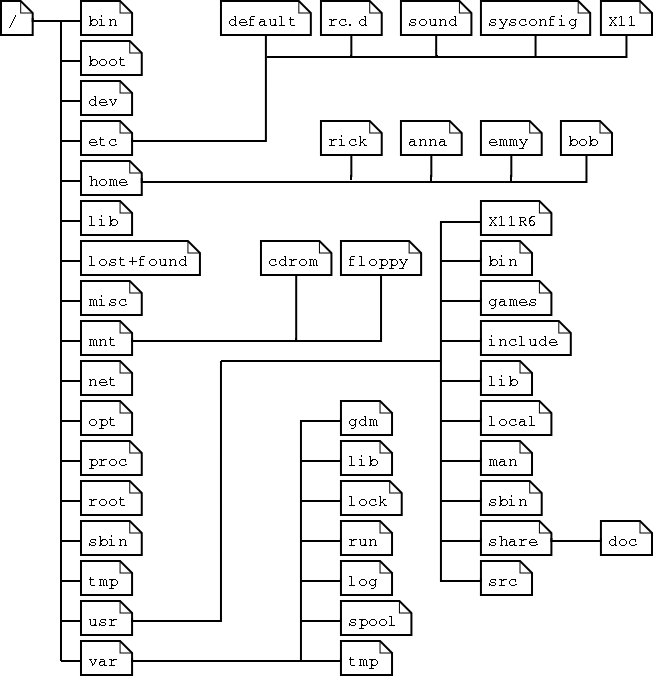3.1.1. Files
3.1.1.1. General
A simple description of the UNIX system, also applicable to Linux, is this:"
On a UNIX system, everything is a file; if something is not a file, it is a process."
A Linux system, just like UNIX, makes no difference between a file and a directory, since a directory is just a file containing names of other files. Programs, services, texts, images, and
so forth, are all files. Input and output devices, and generally all devices, are considered to be files, according to the system.
a partition for user programs (/usr)
a partition containing the users' personal data (/home)
a partition to store temporary data like print- and mail-queues (/var)
a partition for third party and extra software (/opt)
For convenience, the Linux file system is usually thought of in a tree structure.
igure 3-1. Linux file system layout
Table 3-2. Subdirectories of the root directory
| Directory | Content | /binCommon programs, shared by the system, the system administrator and the users./bootThe startup files and the kernel, vmlinuz. In some recent distributions also grub data. Grub is the GRand Unified Boot loaderand is an attempt to get rid of the many different boot-loaders we know today./devContains references to all the CPU peripheral hardware, which are represented as files with special properties./etcMost important system configuration files are in /etc, this directory contains data similar to those in the Control Panel in Windows/homeHome directories of the common users./initrd(on some distributions) Information for booting. Do not remove!/libLibrary files, includes files for all kinds of programs needed by the system and the users./lost+foundEvery partition has a lost+found in its upper directory. Files that were saved during failures are here./miscFor miscellaneous purposes./mntStandard mount point for external file systems, e.g. a CD-ROM or a digital camera./netStandard mount point for entire remote file systems/optTypically contains extra and third party software./procA virtual file system containing information about system resources. More information about the meaning of the files in proc is obtained by entering the command man proc ina terminal window. The file proc.txt discusses the virtual file system in detail./rootThe administrative user's home directory. Mind the difference between /, the root directory and /root, the home directory of the root user./sbinPrograms for use by the system and the system administrator./tmpTemporary space for use by the system, cleaned upon reboot, so don't use this for saving any work!/usrPrograms, libraries, documentation etc. for all user-related programs./varStorage for all variable files and temporary files created by users, such as log files, the mail queue, the print spooler area, space for temporary storage of files downloaded from the Internet,or to keep an image of a CD before burning it.How can you find out which partition a directory is on? Using the df command with a dot (.) as an option shows the partition the current directory belongs to,
and informs about the amount of space used on this partition:
sandra:/lib> df -h .
Filesystem Size Used Avail Use% Mounted on
/dev/hda7 980M 163M 767M 18% /
